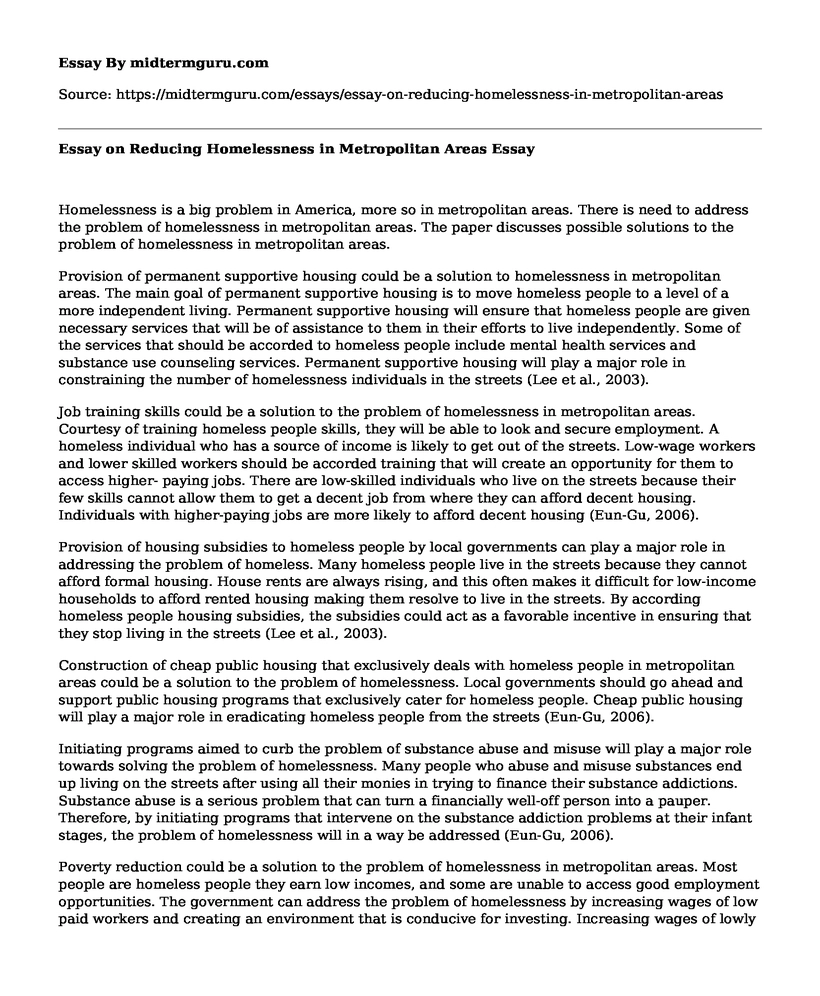Homelessness is a big problem in America, more so in metropolitan areas. There is need to address the problem of homelessness in metropolitan areas. The paper discusses possible solutions to the problem of homelessness in metropolitan areas.
Provision of permanent supportive housing could be a solution to homelessness in metropolitan areas. The main goal of permanent supportive housing is to move homeless people to a level of a more independent living. Permanent supportive housing will ensure that homeless people are given necessary services that will be of assistance to them in their efforts to live independently. Some of the services that should be accorded to homeless people include mental health services and substance use counseling services. Permanent supportive housing will play a major role in constraining the number of homelessness individuals in the streets (Lee et al., 2003).
Job training skills could be a solution to the problem of homelessness in metropolitan areas. Courtesy of training homeless people skills, they will be able to look and secure employment. A homeless individual who has a source of income is likely to get out of the streets. Low-wage workers and lower skilled workers should be accorded training that will create an opportunity for them to access higher- paying jobs. There are low-skilled individuals who live on the streets because their few skills cannot allow them to get a decent job from where they can afford decent housing. Individuals with higher-paying jobs are more likely to afford decent housing (Eun-Gu, 2006).
Provision of housing subsidies to homeless people by local governments can play a major role in addressing the problem of homeless. Many homeless people live in the streets because they cannot afford formal housing. House rents are always rising, and this often makes it difficult for low-income households to afford rented housing making them resolve to live in the streets. By according homeless people housing subsidies, the subsidies could act as a favorable incentive in ensuring that they stop living in the streets (Lee et al., 2003).
Construction of cheap public housing that exclusively deals with homeless people in metropolitan areas could be a solution to the problem of homelessness. Local governments should go ahead and support public housing programs that exclusively cater for homeless people. Cheap public housing will play a major role in eradicating homeless people from the streets (Eun-Gu, 2006).
Initiating programs aimed to curb the problem of substance abuse and misuse will play a major role towards solving the problem of homelessness. Many people who abuse and misuse substances end up living on the streets after using all their monies in trying to finance their substance addictions. Substance abuse is a serious problem that can turn a financially well-off person into a pauper. Therefore, by initiating programs that intervene on the substance addiction problems at their infant stages, the problem of homelessness will in a way be addressed (Eun-Gu, 2006).
Poverty reduction could be a solution to the problem of homelessness in metropolitan areas. Most people are homeless people they earn low incomes, and some are unable to access good employment opportunities. The government can address the problem of homelessness by increasing wages of low paid workers and creating an environment that is conducive for investing. Increasing wages of lowly paid workers will play a major role in motivating homeless individuals to cease sleeping in the streets and go ahead and search for affordable housing. Creating a conducive environment for investing will create jobs that will be taken up by some of the homeless people in the metropolitan areas. As a result, the number of homeless people in metropolitan areas will reduce (Lee et al., 2003).
References
Eun-Gu, J. (2006). A study of the structural risk factors of homelessness in 52 metropolitan areas in the United States. International Social Work, 49, 1, 107-117.
Lee, B. A., Price-Spratlen, T., & Kanan, J. W. (2003). Determinants of Homelessness in Metropolitan Areas. Journal of Urban Affairs, 25, 3, 335-356.
Cite this page
Essay on Reducing Homelessness in Metropolitan Areas. (2021, Jun 08). Retrieved from https://midtermguru.com/essays/essay-on-reducing-homelessness-in-metropolitan-areas
If you are the original author of this essay and no longer wish to have it published on the midtermguru.com website, please click below to request its removal:
- Questions and Answers on Communication With Customers - Paper Example
- Research Paper on Children and Divorce
- Article Analysis Essay on Culture as a Social Determinant of Mental and Behavioral Health
- Can "The People" Check the President's Actions? - Essay Sample
- Message of Jesus - Essay Sample
- Communication: Transferring Info & Forming Relationships - Essay Sample
- Adolescents, Risk-Taking, and Self-Control: Examining the Relationship - Essay Sample







